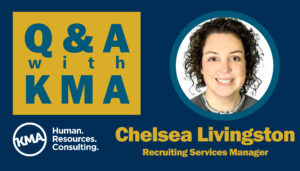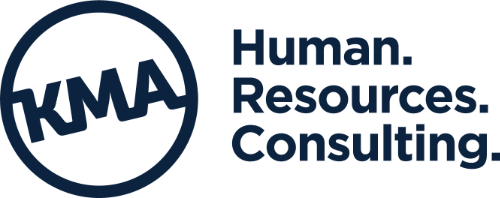 We recently sat down with Chelsea Livingston, KMA’s Recruiting Services Manager, to ask about the current hiring market, and how KMA’s successful recruiting process is designed for efficiency, agility, collaboration, and transparency for all parties. Here are Chelsea’s insights.
We recently sat down with Chelsea Livingston, KMA’s Recruiting Services Manager, to ask about the current hiring market, and how KMA’s successful recruiting process is designed for efficiency, agility, collaboration, and transparency for all parties. Here are Chelsea’s insights.
Q: How important is it to be clear about what you want in your new hire?
Chelsea: The hiring manager needs to be very clear about what they are looking for in a candidate from the outset. This helps us narrow down the talent pool and allows us to reach out to passive candidates as part of our sourcing strategy. It’s all about the prep, and our process involves a detailed download call between the KMA recruiter and our client to get as much of this essential information up front. We need to know what the ideal candidate with bring in terms of experience, degrees/credentialing, skillset – as well as what can the client be flexible on. We encourage our clients to determine what are the absolute must-have qualities, and advise them to keep that list to a minimum so that potentially strong candidates aren’t deterred from applying. We make certain that everyone is on the same page from the start so that the process can be smoother, more time-efficient and ultimately more fruitful.
Q: What are some ways to simplify the screening process?
Chelsea: One tactic for simplifying the screening process, especially for our high-volume clients looking to bring on 20-30 new employees at a time, is we recommend they block time on their calendar for interviews every week. That way, if the KMA recruiter is screening a promising candidate, we can schedule that next step – an interview – in real time. This can be a huge advantage in moving high quality candidates forward and not losing them to other opportunities they have in the works. And during the interview, if things are going well with a candidate we tell our clients to take them on a tour, introduce them to team members, even consider making a verbal offer on the spot.
It’s best to schedule all the in-person interviewing in one day, and to keep everyone on the same page about who is asking which questions, how are you evaluating the candidates, and who is the ultimate decision maker. KMA can develop a rubric for our clients to help them evaluate each candidate numerically, and this can remove some of the subjectivity in decision-making. We can also give direction for each question on what to look for in the candidate’s responses, i.e. look for organizational skills; look for good written communications, etc. Overall, cutting out any extra steps that you can is our best advice in the current recruiting environment.
Q: What’s your recommendation for managing the candidates – even the ones who don’t go forward?
Chelsea: Our approach at KMA is to over-communicate throughout the progression. We let candidates know what the next steps are, when they will hear from us, and where they are in the process. And we always maintain open lines of communication both ways, so that if things change for the candidate – if they receive another offer, for example – we can let our client know right away so they can respond accordingly. With the candidates who aren’t making it through to the next round, again, prompt communication is best. We like to keep the door open and continue the relationship because something could come up in the future. The way candidates are treated can impact your reputation, your employer brand, and you never want to leave anyone hanging and wondering what ever happened. People write reviews on Indeed, Glass Door and social media, so you want to make sure the process is respectful, empathetic and as courteous as possible for every candidate.
Q: What are some ways to identify and remove unnecessary friction from the process?
Chelsea: From the beginning, you want to set up a clear and organized process that everyone is on board with. You don’t want it to feel chaotic or disorganized for the candidates – you want to inspire confidence! Having a large number of interviewers can slow things down, so we recommend a small hiring team, at least until you narrow your candidates down to a few front-runners. At that point, you could bring in more stakeholders, for example, board members, for additional interviews. We are extremely collaborative with our clients, and help manage the timeline – timing is critical. We are still very much in a candidate’s market, and so the decision time needs to be compressed as much as possible. Sometimes a client has to miss out on a great candidate to understand this reality.
When it’s time for the offer, we recommend our clients go in with their best proposal to avoid the back and forth negotiation that’s just another barrier. If it’s the candidate you really want and their salary requirements are within your budget, make your best offer. Playing hardball is not a strong position at the moment, as candidates have so many options and resources available to them. Our advice for making a great hire is: be transparent, be realistic, and go in with your best offer.
Thanks for the great advice, Chelsea!
To speak with one of KMA’s expert recruiters, please reach out to us today at info@kmahr.com
